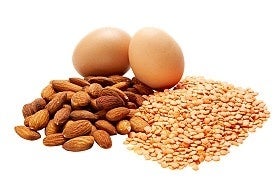 1. Upgrade the protein on your plate. The Healthy Eating Plate encourages you to eat protein-rich foods like beans, nuts, tofu, fish, chicken, or eggs in place of less-healthy options like red and processed meats.
1. Upgrade the protein on your plate. The Healthy Eating Plate encourages you to eat protein-rich foods like beans, nuts, tofu, fish, chicken, or eggs in place of less-healthy options like red and processed meats.
For example, try a turkey or black bean burger instead of a traditional beef burger. Or slice up a fresh-roasted chicken breast or salmon for your sandwich instead of using processed high-sodium lunch meat.
2. Don’t stress too much about protein quantity. Most reasonable diets provide plenty of protein for healthy people. Eating a variety of healthy protein-rich foods—for example an egg with breakfast, some turkey or beans on your salad for lunch, and a piece of salmon or tofu with a whole grain side dish for dinner—will ensure that you get all the protein and protein building-blocks (amino acids) you need. Choose higher-protein foods instead of bulking up with pricey protein shakes or powders, since some of these are loaded with sugar or other additives.
3. Try a meatless Monday—or more. Diets high in plant-based proteins and fats can provide health benefits, so try mixing some vegetarian proteins into your meals. Going meatless can be good for your wallet as well as your health, since beans, nuts and seeds, and other minimally-processed vegetarian protein sources are often less expensive than meat. Eating plant protein in place of meat is also good for the planet. It takes a lot of energy to raise and process animals for meat, so going meatless could help reduce pollution and has the potential to lessen climate change.
4. Eat soy in moderation. Tofu and other soy foods are an excellent red meat alternative. In some cultures, tofu and soy foods are a protein staple, and we don’t suggest any change. But if you haven’t grown up eating lots of soy, there’s no reason to begin eating it in large quantities. And stay away from supplements that contain concentrated soy protein or extracts, such as isoflavones, as we just don’t know their long-term effects.
- Scan the Nutrition Facts label before you buy highly-processed vegetarian “fake meat” foods, since these are often as high in sodium—or higher in sodium—than their processed red meat counterparts.
5. Shift the balance of carbs and protein. Cutting back on highly processed carbohydrates and increasing protein improves levels of triglycerides and protective high-density lipoprotein (HDL) in the bloodstream, and so may reduce your chances of having a heart attack, stroke, or other type of cardiovascular disease. This shift may also make you feel full longer, and stave off hunger pangs.

